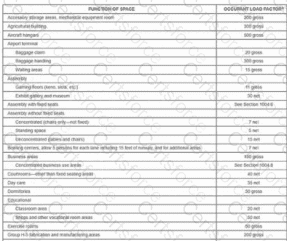Step-by-Step Reasoning
1. Identify the occupancies from the question:
Day care services → Occupant load factor = 35 net (from table in the exhibit)
Exercise classes → Occupant load factor = 50 gross (also from table in the exhibit, under "Exercise room")
2. Determine how to calculate the occupant load for multiple occupancies:
According to IBC 2018, Section 1004.1.2 (Areas without fixed seating) and NCARB PDD study materials:
When multiple occupancies share the same means of egress system, the occupant load for the whole space shall be the sum of the occupant loads of the various occupancies.
However, if the space is not divided and is used interchangeably (multipurpose), the most stringent occupant load factor is applied to the entire area.
3. Applying the code:
The multipurpose room is used for both daycare and exercise.
Since the same space is used for different functions at different times (not divided), the most restrictive occupant load factor (the smaller number) should be used.
Smaller occupant load factor = 35 net (Day care) vs. 50 gross (Exercise room).
4. Why “net” vs. “gross” matters here:
Net floor area excludes certain spaces like walls, corridors, mechanical rooms.
Gross floor area includes the entire footprint.
Even though “net” typically results in a smaller area, when calculating load factors, the smaller occupant load factor number results in a larger occupant load — making it more restrictive for egress.
5. Conclusion:
The correct occupant load factor to use for this multipurpose space = 35 net (Day care), as it results in the largest occupant load and is the most restrictive for egress design.
NCARB ARE 5.0 PDD Study Guide References:
Content Area: Code Analysis — Occupant Load & Egress Sizing
IBC 2018, Section 1004.1.2 — Areas without fixed seating, determining occupant load for multiple functions
Architectural Graphic Standards — Occupant Load Calculation examples
Building Codes Illustrated by Ching & Winkel — Chapter on Occupancy Load Factors and Egress Requirements

Submit